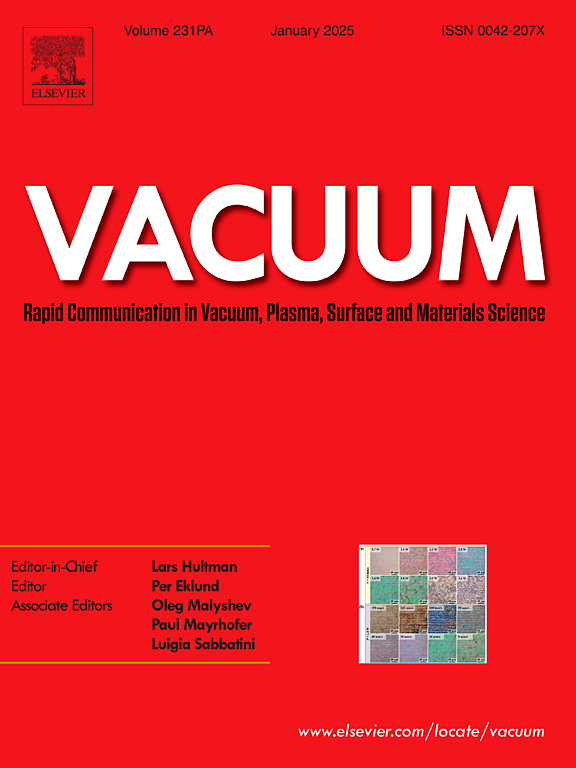具有碳势垒的La/B4C多层结构用于~ 6.7 nm EUV的物理和化学分析
IF 3.8
2区 材料科学
Q2 MATERIALS SCIENCE, MULTIDISCIPLINARY
引用次数: 0
摘要
采用磁控溅射技术,制备了一系列具有不同c势垒的La/B4C多层膜,溅射波长约为6.7 nm。利用掠入射x射线反射法、原子力显微镜、高分辨率透射电镜和能量色散x射线能谱法研究了具有不同势垒层的多层膜的物理结构。发现在B4C-on-La界面上添加0.2 nm的碳势垒比在其他界面或更厚的界面上添加C势垒略微改善了材料的物理结构。深入的x射线光电子能谱测量表明,C-La键的形成增加,这可能降低了界面竞争反应中光学不利的B-La键的含量。根据硬x射线和EUV反射率的拟合结果,发现C势垒沉积后层间密度降低。分析认为,La/B4C/C多层膜的EUV反射率增强与层间密度的降低和层间成分的不同有关。c -阻挡样品在6.640 nm处的最高反射率为49.4%,而无阻挡样品在6.616 nm处的最高反射率为37.6%。本文章由计算机程序翻译,如有差异,请以英文原文为准。
Physical and chemical analysis of La/B4C multilayer structure with carbon barriers for ∼6.7 nm EUV application
A series of La/B4C multilayers with different C-barriers were deposited using magnetron sputtering dedicated for a wavelength ca. 6.7 nm wavelength. Grazing incidence X-ray reflectometry, atomic force microscopy, high-resolution transmission electron microscopy, and energy-dispersive X-ray spectroscopy were used to investigate the physical structure of the multilayer with different barrier layers. It was found that 0.2 nm carbon barrier at the B4C-on-La interface slightly improved the physical structure especially compared to adding C barrier at the other interface or with larger thickness. In-depth X-ray photoelectron spectroscopy profile measurements indicated an increased formation of C-La bond, which potentially decreased the content of the optically unfavorable B-La bond in the competitive reaction at interfaces. A reduced interlayer density was also found after the deposition of C barrier according to the fitted results of hard X-ray and EUV reflectance. It is estimated that the reduced density and different composition of the interlayer contribute to the enhanced EUV reflectance of the La/B4C/C multilayer. The highest reflectance for the C-barrier sample is 49.4 % at 6.640 nm, while the highest reflectance for the No-barrier sample is 37.6 % at 6.616 nm.
求助全文
通过发布文献求助,成功后即可免费获取论文全文。
去求助
来源期刊

Vacuum
工程技术-材料科学:综合
CiteScore
6.80
自引率
17.50%
发文量
0
审稿时长
34 days
期刊介绍:
Vacuum is an international rapid publications journal with a focus on short communication. All papers are peer-reviewed, with the review process for short communication geared towards very fast turnaround times. The journal also published full research papers, thematic issues and selected papers from leading conferences.
A report in Vacuum should represent a major advance in an area that involves a controlled environment at pressures of one atmosphere or below.
The scope of the journal includes:
1. Vacuum; original developments in vacuum pumping and instrumentation, vacuum measurement, vacuum gas dynamics, gas-surface interactions, surface treatment for UHV applications and low outgassing, vacuum melting, sintering, and vacuum metrology. Technology and solutions for large-scale facilities (e.g., particle accelerators and fusion devices). New instrumentation ( e.g., detectors and electron microscopes).
2. Plasma science; advances in PVD, CVD, plasma-assisted CVD, ion sources, deposition processes and analysis.
3. Surface science; surface engineering, surface chemistry, surface analysis, crystal growth, ion-surface interactions and etching, nanometer-scale processing, surface modification.
4. Materials science; novel functional or structural materials. Metals, ceramics, and polymers. Experiments, simulations, and modelling for understanding structure-property relationships. Thin films and coatings. Nanostructures and ion implantation.
 求助内容:
求助内容: 应助结果提醒方式:
应助结果提醒方式:


